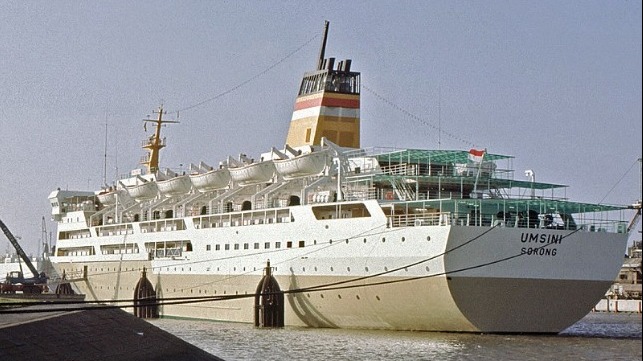Indonesia Turns Passenger Ferries into COVID-19 Isolation Centers

Indonesia is converting its inter-island passenger-cargo ships into COVID-19 isolation centers as part of an ongoing attempt to contain the Delta variant of COVID-19, which has been spreading rapidly through the country in recent weeks. In July the country was averaging 50,000 cases a day of COVID-19, but in part due to the government's containment strategies the case rate has fallen by more than half to an average of 22,000 a day. The government plans to expand its efforts with the passenger ferries as the next phase of the efforts to slow the spread of the virus and provide more facilities to threat the sick.
In the port city of Makassar in South Sulawesi, authorities last month reconfigured the KM Umsini, a 14,500 gross ton passenger ferry into a floating isolation center for patients who test positive for COVID-19 but project mild or no symptoms. The goal was to contain the spread of the highly infectious Delta variant. The 36-year-old KM Umsini that normally accommodates 1,600 passengers and cargo is serving as an isolation center with 800 beds and 60 medical workers attending to COVID-19 patients. Features installed aboard the vessel were designed to support the implementation of self-isolation, such as the provision of surveillance cameras, polyclinics and jogging tracks with the top deck being converted to an open space for exercising or sunbathing. Patients also have ability to listen to music and participate in fishing from the ship’s deck to pass their time while in quarantine.
Last week, state-owned PT PELNI (Persero) which operates the ferries committed to make available another four passenger ships to serve as floating isolation locations. The four ships include KM Tatamailau, which will dock at Bitung , KM Bukit Raya at Belawan port, KM Sirimau at Sorong port and KM Tidar at Jayapura port. The four ships will make available a total of 906 beds for COVID-19 patients and 23 beds for medical personnel.
“Before use, all ships will be sterilized and equipped with supporting facilities for the implementation of floating isolation by the local government and agencies. This must be done in order to meet the standards as an independent isolation location as determined by the Ministry of Health as has been done at KM Umsini in Makassar,” said Insan Purwarisya Tobing, presdent director of PT PELNI. State-owned PT PELNI is engaged in sea transportation operating 26 passenger and cargo ships that serve 76 portsacross the country.
Indonesia, which is one of Asia’s worst-hit COVID-19 countries, witnessed a significant surge in infections in recent weeks prompting the government to implement a multi-tiered community activity restriction scheme to reduce the daily infection rate. But, according to world health authorities, the country remains as the epicenter of the pandemic in Southeast Asia with 3.8 million confirmed cases and total deaths reaching more than 117,000.
On Monday, President Joko “Jokowi” Widodo delivered the state of the nation speech in which he admitted that COVID-19 pandemic has brought with it exhaustion, boredom, weariness, sadness, and distress besides devastating the economy. “The pandemic has indeed significantly slowed down our economic growth, but it must not hinder the process of structural reforms of our economy,” he said.
To contain the pandemic, the government vowed to improve testing and treatment, including vaccinations. Currently, only 15 percent of the country’s 270 million population has been inoculated.
Indonesia is not the first country to use passenger ships to create additional medical beds for isolation. Early in the pandemic, Italy also used ferries and cruise ships to provide additional ward space for those that were not critically ill. Italy has also used ferries to create isolation wards for some of the migrants reaching its shores.
Photo by Wolfgang Frike of the Umsini when built in 1985 under CCbyA3 license)
